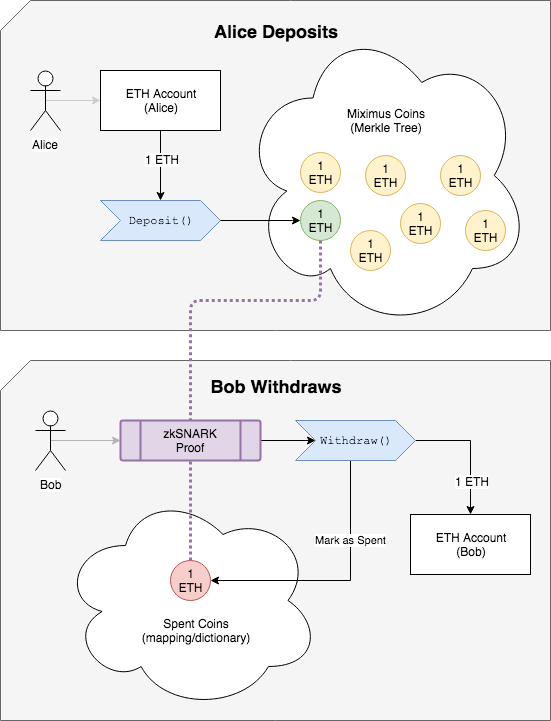Miximus is a self-service coin mixer and anonymous transfer method for Ethereum, it accepts deposits of 1 ETH, then allows you to withdraw coins by providing a zkSNARK proof that proves you know the spend key for one unspent coin without revealing which one it is.
For more information, see:
The zkSNARK prover is built as a native library which can plug-in to your application, when provided with the correct arguments it returns the zkSNARK proof as JSON. While you may think of zkSNARKs as being slow - the algorithms chosen for Miximus mean proofs can be made in 5 seconds, however we're still studying their security properties.
The following dependencies (for Linux) are needed:
- cmake 3
- g++ or clang++
- gmp
- libcrypto
- boost
- npm / nvm
Requires Brew and nvm.
make git-submodules # Pull sub-repositories
make -C ethsnarks mac-dependencies
make -C ethsnarks python-dependencies
nvm install --lts
make
make git-submodules # Pull sub-repositories
sudo make -C ethsnarks ubuntu-dependencies
make -C ethsnarks python-dependencies
nvm install --lts
make
yum install cmake3 boost-devel gmp-devel
nvm install --lts
make git-submodules # Pull sub-repositories
make -C ethsnarks python-dependencies
make CMAKE=cmake3
Alice wants to transmit 1 coin to Bob
- Bob gives Alice the hash of a secret that only he knows
- Alice sends 1 ETH to the 'Deposit()' method of the Miximus smart contract, with that hash
- The 'Coin' gets inserted into a merkle tree of coins, all coins are 1 ETH
- Bob makes a zkSNARK proof, using the secret, that proves he owns that coin The proof includes an unlinkable 'spent tag', which prevents the same coin being spent twice
- Bob sends the Proof and the 'spent tag' to the Withdraw() method of the Miximus smart contract
- If the coin hasn't been spent, the contract deposits 1 ETH to Bob
For Alice to send a coin to Bob she needs the hashed secret from Bob. Bob makes the random secret (a random field element, modulo the zkSNARK prime being used):
coin_secret = FQ.random()
Bob passes the hash of that secret to Alice:
bobs_leaf = H(coin_secret) # Generated using `MakeLeafHash()` method of the smart-contract
Alice sends bobs_leaf with the Deposit, this is the leaf of the Merkle tree of coins. Bob can see when Alice has made his deposit by monitoring the OnDeposit event of the smart contract. Only Bob knows the secret, so only Bob can make a successful zkSNARK proof.
Bob fetches the Merkle tree path from the smart contract (without doing an on-chain transaction, as that would reveal his coin) using the leaf_index parameter in the OnDeposit event and the GetPath() method of the smart-contract, along with the current merkle root from the GetRoot() method.
Bob fetches his external_hash from the smart contract using GetExtHash(), this is a hash of the contract address and his Ethereum address. It means that only his account can submit the proof he generates to that specific smart contract, preventing re-plays and other malicious activity.
Only the external_hash, nullifier and merkle_root parameters are public and observable on-chain, the rest are secret inputs for the zkSNARK proof.
def circuit(secret, path_var, address_bits, nullifier, root, external_hash, pub_hash):
assert H(root, nullifier, external_hash) == pub_hash
leaf_hash = H(secret) # Prove we know the secret for the leaf
assert root == merkle_authenticate(path_var, address_bits, leaf_hash) # Prove that leaf exists within the tree
assert H(address_bits, secret) == nullifierThe circuit verifies:
- that the leaf exists within the merkle tree
- that prover knows the secret for that leaf
- that the nullifier (spent tag) is derived from the leaf and the
And because this is a zkSNARK proof, all of this is done without revealing to anybody else which exact leaf it is within the tree, but if Bob tries to make two proofs for the same leaf (even using different Merkle roots) the nullifier will be the same - preventing him from double-spending.
Miximus doesn't use keys (or secp256k1), it just uses secrets and hashing. The zkSNARK proof allows you to prove you know what the secret is, without revealing it to anybody. The hash function used is MiMC, it operates over a prime field rather than on bytes and bits.
